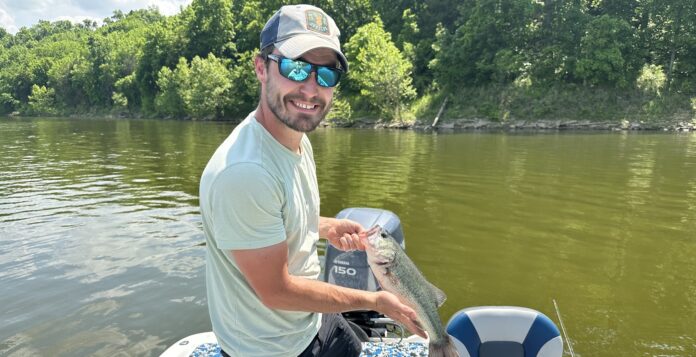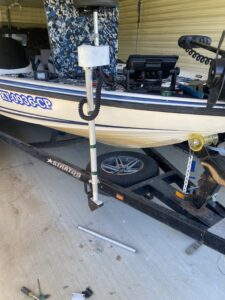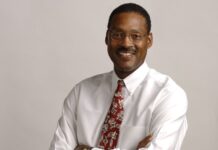
They say a bad day of fishing is better than a good day at work. But for two UofL alumni, their hard work will soon mean more good days of fishing for anglers everywhere. Gus Ford and Jack Manzella recently collaborated to develop an innovative new fishing-finding technology called Steady Scope.
Ford, who graduated from UofL’s J.B. Speed School of Engineering with his bachelor’s degree in mechanical engineering in 2014, has been a self-proclaimed maker his entire life. Now, as a senior design engineer at FirstBuild with his Steady Scope technology moving to production, he can call himself an inventor.
Manzella, who graduated from UofL’s College of Business with his master’s degree in business administration in entrepreneurship, is a senior digital marketing specialist at FirstBuild, where he established their revolutionary Blitz Process for idea development which helped Steady Scope become a reality. Manzella also is an Entrepreneur-In-Residence at UofL, where he mentors student-led start-ups, provides support for initiatives at the Forcht Center for Entrepreneurship and teaches courses in management and entrepreneurship.
UofL News caught up with Ford and Manzella to learn more about their accomplishment and how their time at UofL helped fuel their passion for entrepreneurial creativity and innovation.
UofL News: What is Steady Scope and what makes it different from other fish-finding technology on the market?
Ford: Steady Scope is a gyro-stabilized transducer mount. And that’s just a complicated way to say, it’s a pole that turns. But what’s unique about Steady Scope is that it’s a solution to a problem that came about with the advent of forward-facing sonar in fishing around 2018. Traditionally, fish finders were just a cone that would go downward. I like to use the analogy of an underwater flashlight. If you just shine it straight down, it doesn’t really matter if you turn because your flashlight is just a downward cone, but when you face that flashlight forward, like the headlights on your car, they have to shine in the direction you want to see. So, Steady Scope keeps your sonar facing in the direction you are wanting to see no matter how much your boat is moving with the wind or the wave.
As a fisherman myself, I was adopting this new technology, which led me to look for something to buy and put on my boat, but there wasn’t anything that actually solved the problem. The options that were out there for what was essentially a pole that turned were $700 to $900, which were ridiculous prices for the technology. So, we immediately identified that there was room for a high margin product in the space where the technical feasibility was pretty easy to accomplish.

UofLNews: FirstBuild is typically known for its home appliances, so how did the idea for a fishing product come to fruition?
Manzella: Something that’s amazing about FirstBuild is that we are here to explore new markets for GE appliances. While Steady Scope is definitely not a typical appliance, it kind of fits into GE’s mission to “enable happiness and wellbeing in every home.” Gus was able to use our Blitz Process, which is how we validate that anyone cares about these new invention ideas. It involves a lot of what we call customer discovery, or going out and talking to real customers at the very early stages of idea development to make sure that these people actually care about what you’re working on.
I’ll be honest, when Gus first explained Steady Scope to me, I didn’t understand it at all, but he did such a great job of going out and performing customer discovery and engaging with the fishing community that the data he gathered was irrefutable. The people were so excited about this product that Gus knew that he had a winning idea early on.
UofL News: What was your process for customer discovery and what kind of response did you receive?
Ford: At FirstBuild, our whole mission is co-creation. So, I initially put out some Facebook posts with some CAD (computer-aided design) drawings and kind of verbally described what the idea was, and the response was lukewarm. But then I posted a video of me just holding a 3D-printed prototype in my kitchen and rotating it and – Boom! – people actually understood it. Once the idea was understood, it kind of went viral. That rough video shared on my personal Facebook page – not even backed by FirstBuild – was liked and shared with hundreds of comments on it.
UofL News: Does the feedback you receive during customer discovery influence product development or design?
Ford: Absolutely! When we shared it on the FirstBuild YouTube channel, we started getting a lot of feedback about different control options and mounting applications. That feedback drove us to try to create a universal product that would work for multiple applications beyond my initial scope. That is FirstBuild’s process of co-creation. Being very open and forthright with your development process let’s people kind of guide you and help identify a market that you didn’t initially target.
While Steady Scope started as a 20-foot bass boat type product, it has grown into a product that is more or less universal. Kayak fishing is growing to be a pretty big market segment, so coming up with a solution that fit all those different consumers not only expanded our markets and sales potential, but also helped us develop our product to be more of a universal fit for everyone.
UofL News: At FirstBuild, what is the process for launching new products, like Steady Scope?
Manzella: When we launch new products, we want to have confidence that there is enough demand for the product to justify launching it. So, we try to understand how large the market is through some very in-depth data and analytics and then set an appropriate crowdfunding goal from there. Part of the goal is usually used to justify the cost of tooling up the product – ‘What is it going to take to manufacture this product?’ And then another part of the goal is that we really want the community to pull this product into the market, not just us pushing it into the market. So, we want to make these goals kind of challenging to the point where there is a high enough volume that customers are pulling the product from us.
UofL News: Now that Steady Scope met its crowdfunding goal, what’s next?
Ford: We are moving toward production. We’re finishing our validation and starting to work with our micro-factory, which is largely student labor. It’s basically any college-age students, but we get a lot of UofL students. We do low volume production and house. The unique thing about FirstBuild is we can take an idea from prototype to production right here. So, that’s where we are now. We are putting together our manufacturing plan, shipping and logistics, starting to cut tools and get the manufacturing process ready, so that we can start delivering these this year.
UofL News: Is there anything else you all would like to mention?
Manzella: Sure. We have a fully functional micro-factory at FirstBuild and many students, specifically UofL engineering students, come to FirstBuild to work in our micro-factory, which provides a lot of hands-on experience. We’d love to see more UofL students working on projects in our free Makerspace, because it is a resource right here on campus.
Ford: Go Cards! And go fishing!
by Karen Coombs, Office of Communications & Marketing
































